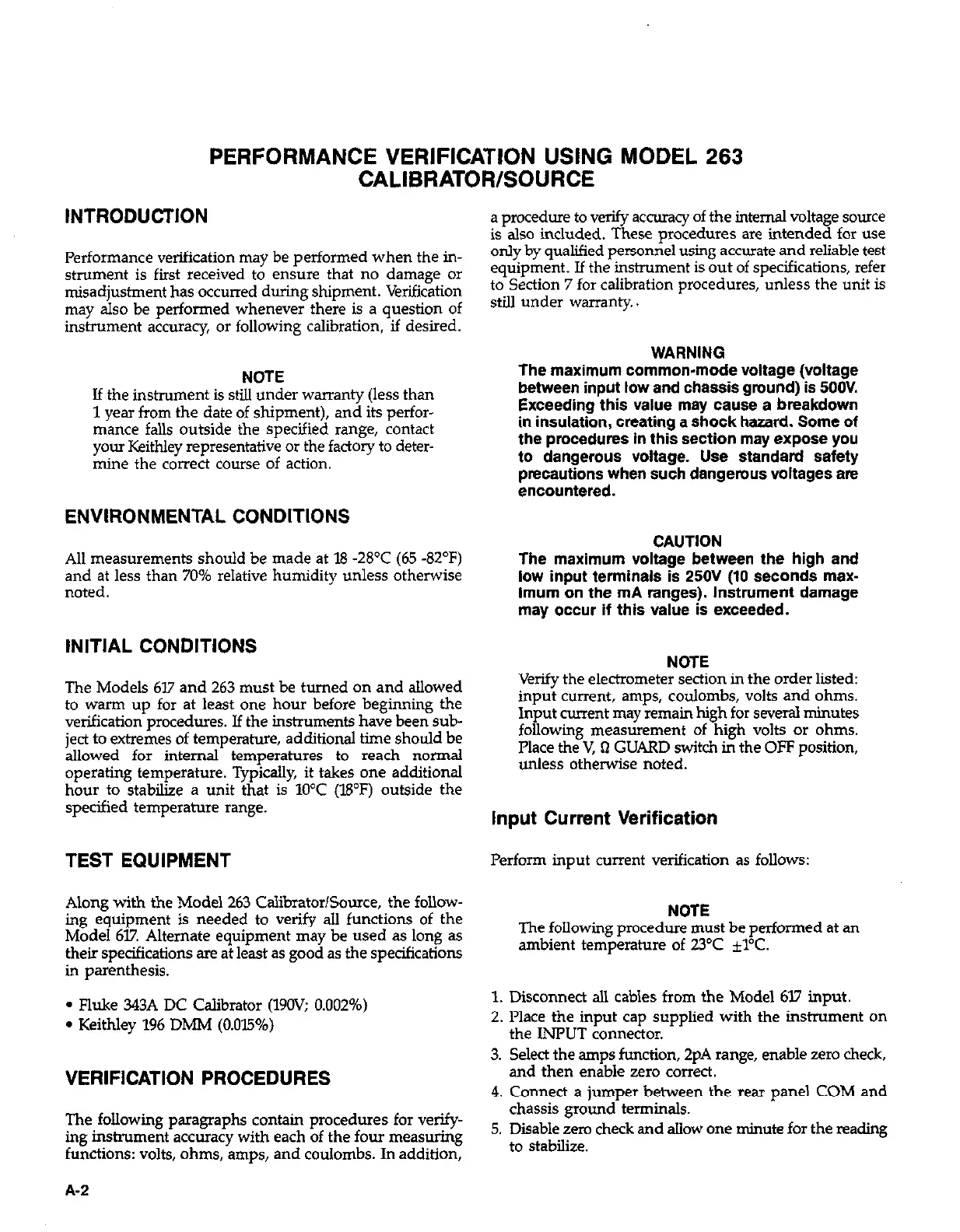PERFORMANCE VERIFICATION USING MODEL 263
CALIBRATOR/SOURCE
INTRODUCTION
Performance verification may be performed when the in-
strument is first received to ensure that no damage or
misadjustment has occurred during shipment. Verification
may also be performed whenever there is a question of
inshument accuracy, or following calibration, if desired.
NOTE
If the instrument is sti!J under warranty (less than
1 year from the date of shipment), and its perfor-
mance falls outside the specified range, contact
your Keithley representative or the factory to deter-
mine the correct course of action.
ENVIRONMENTAL CONDITIONS
All measurements should be made at 18 -28’C (65 -8PF)
and at less than 70% relative humidity unless otherwise
noted.
INITIAL CONDITIONS
The Models 617 and 263 must be turned on and allowed
to warm up for at least one hour before beginning the
verification procedures. If the instruments have been sub-
ject to extremes of temperature, additional time should be
allowed for internal temperatures to reach normal
operating temperature. Typically, it takes one additional
hour to stabilize a unit that is 10°C (WF) outside the
specified temperature range.
TEST EQUIPMENT
Along with the Model 263 Calibrator/Source, the follow-
ing equipment is needed to verify all functions of the
Model 617. Alternate equipment may be used as long as
their specifications are at least as good as the specifications
in parenthesis.
l Fluke 343A DC Calibrator (19OV; 0.002%)
l Keithley 196 DMh4 (O.OW/)
VERIFICATION PROCEDURES
The following paragraphs contain procedures for verify-
ing instrument accuracy with each of the four measuring
functions: volts, ohms, amps, and coulombs. In addition,
A-2
a procedure to verify accuracy of the internal voltage source
is also included. These procedures are intended for use
only by qualified personnel using accurate and reliable test
equipment. If the instrument is out of specifications, refer
to Section 7 for calibration procedures, unless the unit is
still under warranty..
WARNING
The maximum common-mode voltage (voltage
between incut low and chassis around) is 5OOV.
Exceeding’this value may cause a breakdown
in insulation, creating a shock hazard. Some of
the procedures in this section may expose you
to dangerous voltage. Use standard safety
precautions when such dangerous voltages are
encountered.
CAUTION
The maximum voltage between the high and
low input terminals is 250V (10 seconds max-
imum on the mA ranges). Instrument damage
may occur if this value is exceeded.
NOTE
Verify the electrometer section in the order listed:
input current, amps, coulombs, volts and ohms.
Input current may remain high for several minutes
following measurement of high volts or ohms.
Place the V, fl GUARD switch in the OFF position,
unless otherwise noted.
Input Current Verification
Perform input current verification as follows:
NOTE
The following procedure must be performed at an
ambient temperature of 23°C QC.
1. Disconnect all cables from the Model 6X7 input.
2. Place the input cap supplied with the instrument on
the INPUT connector.
3. Select the amps function, 2pA range, enable zero check,
and then enable zero correct.
4. Connect a jumper between the rear panel COM and
chassis ground terminals.
5. Disable zero check and allow one minute for the reading
to stabilize.
